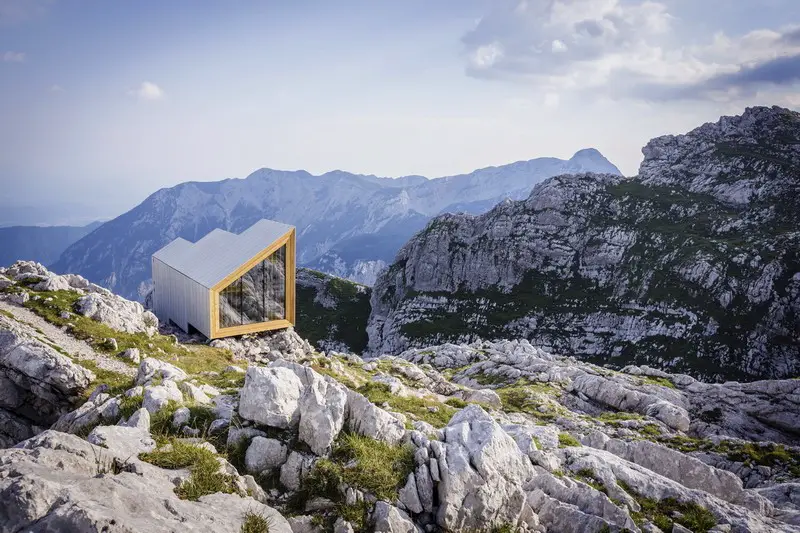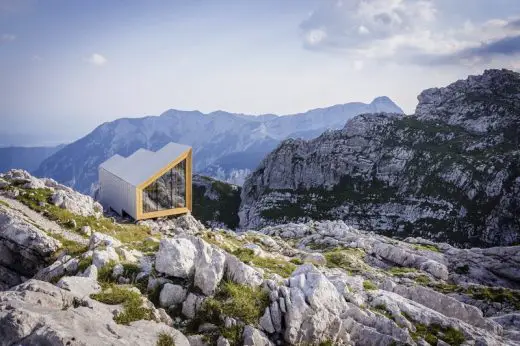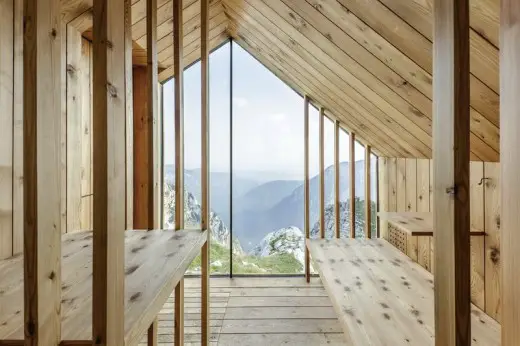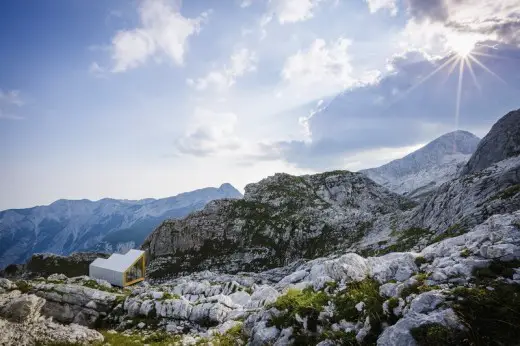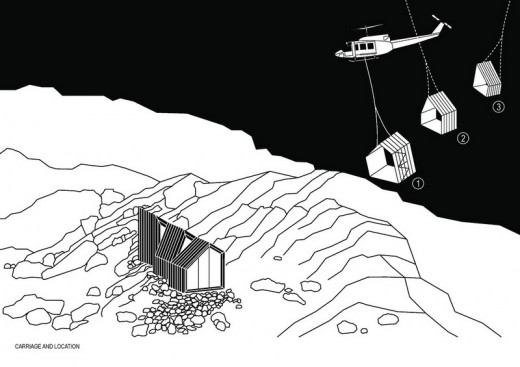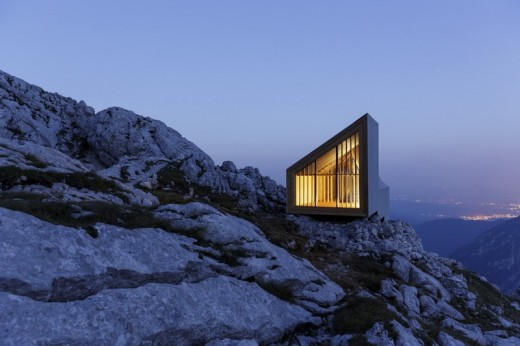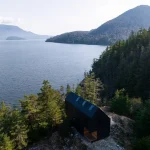Alpine Shelter, Contemporary Slovenian Cottage, Architect, Images, Glacier Design
Alpine Shelter on Mountain Skuta
Mountain Skuta Building: Contemporary Slovenian Cottage design by OFIS ARCHITECTS
14 Jan 2016
Alpine Shelter on Mountain Skuta, Slovenia
Location: Mountain Skuta, Slovenia
Design: OFIS ARCHITECTS
Mountain Skuta Alpine Shelter
The extreme climatic conditions in the mountains introduce a design challenge for architects, engineers and designers. Within a context of extreme risk to environmental forces, it is important to design buildings that can withstand extreme weather, radical temperature shifts, and rugged terrain. Responding to environmental conditions is not only a protective measure, but also translates into a matter of immediate life safety. The harsh conditions of wind, snow, landslides, terrain, and weather require a response of specific architectural forms and conceptual designs.
120 years after the installation of Aljaz Tower in August of 1895 on Triglav*, this new shelter was placed below Mountain Skuta in Kamnik Alps. It is replacing a 50 year old bivouac that had previously been on the site.
The bivouac is an object that represents a basic human necessity, a shelter. It is a symbol of refuge. The outer form and choice of materials were chosen to respond the extreme mountain conditions, and also provide views to the greater landscape. Its position within the wilderness requires respect for natural resources, therefore must meet the ground in a light and firm manner to ensure the shelter is strongly anchored while having a minimal impact on the ground.
In addition, the outer shell needed to be realised with a highly resistant material and in collaboration with Rieder thin glass fibre öko skin concrete elements were able to meet all the requirements of aesthetics, material quality and the challenge of being able to withstand especially rigorous weather conditions.
The design of the interior dictates modesty, totally subordinate to the function of the shelter providing accommodation for up to eight mountaineers.
Informed by traditional alpine architecture, building elements, materials, structure and form, the design scheme by students Frederick Kim, Katie MacDonald and Erin Pellegrino was selected. After conclusion of the academic semester, OFIS architects and structural engineers AKT ll continued to and develop and adapt the form to the given site, responding to further input from the mountaineers, Anze Cokl, Milan Sorc and other engineers and lead the project throughout the realization planning phase.
The design consists of three modules, in part to allow for transport and also to programmatically divide the space. The first is dedicated to the entrance, storage and a small space for the preparation of food. The second one provides space for both, sleeping and socializing while the third features a bunk sleeping area. Windows at both ends offer beautiful panoramic views of the valley and Skuta Mountain.
Due to the nature of the installation process, the shelter was designed as a series of modules so that it could be brought to the mountain in parts. The entire prototype was constructed off-site in the workshop. The modules were planned as a series of robust frames, which would then be braced together onsite providing a manageable installation and a less invasive foundation. In order to keep the mountain site as undisturbed as possible, the modules are fastened onto strategically placed pin connections, which also act as the foundation on the site.
The glass is a triple pane system that has been calculated to withstand to the projected strong wind and snow loads. Installation of the bivouac was carried out by PD Ljubljana Matica under the direction of Matevz Jerman, helicopter transport while the Slovenian Armed Forces and a team of Mountain Rescue Service – station Ljubljana. The whole transportation and installation process was carried out in one day.
Although the scale of the bivouac is small, the project required a lot of effort and planning from over sixty participants who were mostly volunteers and sponsors. All would agree that, despite the small size, it was no less demanding than any large building project. However, all of the effort and planning for this small scale project is meant to keep the memory, spirit and culture of the mountains as a special place for Slovenians. The hope is that the bivouac will serve as a shelter for all of the climbers who need it, and that through their care and attention the bivouac will continue to do so for many years.
* The highest mountain in Slovenia and the highest peak of the Julian Alps. The mountain is the pre-eminent symbol of the Slovene Nation. It is the centerpiece of the Triglav National Park, Slovenia’s only national park.
Alpine Shelter – Building Information
OFIS architects and AKT II in collaboration with students at Harvard University Graduate School of Design, Freeaproved and PD Ljubljana Matica
The research for the shelter was initiated during the course of the design studio, Habitation in Extreme Environments (Harvard GSD, Fall 2014).
The following team developed the final design:
Instructors / Architects:
Rok Oman, OFIS architects ; Spela Videcnik, OFIS architects
Student Design Team, Harvard GSD:
Frederick Kim, Katie MacDonald, Erin Pellegrino
OFIS architects Team:
Andrej Gregoric, Janez Martincic, Maria Della Mea, Vincenzo Roma, Andrea Capretti, Jade Manbodh, Sam Eadington
Structural Engineering:
AKT II, London, UK – Hanif Kara, Edward Wilkes
Local Structural Engineering:
Projecta, Milan Sorc
Engineering & Consulting:
Freeapproved, Anze Cokl
Realization & onsite Coordination:
PD Ljubljana Matica, Slovenia – Matevz Jerman, Davor Rozman
Façade – öko skin:
Rieder Smart Elements, Austria – Wolfgang Rieder, Matthias Kleibel
Glazing:
Guardian, USA – Domen Komac
Bivouac maintenance representatives:
Matevz Jerman, Davor Rozman
Principal Contractor:
Permiz d.o.o., Slovenia – Bostjan Perme
Anchors and Fixation:
Hilti, Slovenia
Thermal and fire safe insulations:
ROCKWOOL stone wool
Site Preparation and Construction Team:
Alpinist section PD Ljubljana Matica, Visinska dela Orti
Team: Matevz Jerman, Jernej Ortar, Blaz Ortar, Davor Rozman, Natasa Vodopivec, Matevz Kastrin, Boris Mance, Boris Bokavsek, Luka Klemencic, Ziga Asic, Jernej Knop, Anze Klaric, Uros Grilj, Marko Granda, Bostjan Oblak
Helicopter Flights:
Slovenian Army
Tomaz Perse, Primoz Pintar, Andrej Groselj, Peter Smrkolj
Support at Installation: Mountain Rescue Association of Slovenia, GRZS
Brane Zorz, Tadej Mrak, Bojan Goli
Photo courtesy @ Anze Cokl
Special thanks to Harvard University Graduate School of Design,
who made the studio possible through the generous support of the John T.Dunlop Professorship in Housing and Urbanization
Mohsen Mostafavi, Dean and Alexander and Victoria Wiley Professor of Design
Iñaki Ábalos, Architecture Department Chair
And to all the students who participated in the Habitation in Extreme Environments Studio:
Myrna Ayoub, Oliver Bucklin, Zheng Cui, Lauren McClellan, Michael Meo, Nadia Perlepe, Elizabeth Pipal, Tianhang Ren, Xin Su
Sponsors:
Rieder Smart Elements, Maishofen, Austria
AKT II, London, UK
OFIS architects, Ljubljana, Slovenia
Guardian Europe, Luxemburg
Hilti, Trzin, Slovenia
Ravago, Store, Slovenia
PGM Hotic, Slovenia
Visinska dela Orti, Slovenia
ROCKWOOL Adriatic, Croatia
Photography: Anze Cokl
Alpine Shelter on Mountain Skuta images / information from OFIS
Location: Skuta, Slovenia
Slovenian Architecture
Slovenian Architecture Designs – chronological list
Cultural Center of European Space Technologies, Vitanje
Design: Bevk Perovic arhitekti, Dekleva Gregoric arhitekti, OFIS arhitekti, Sadar Vuga arhitekt
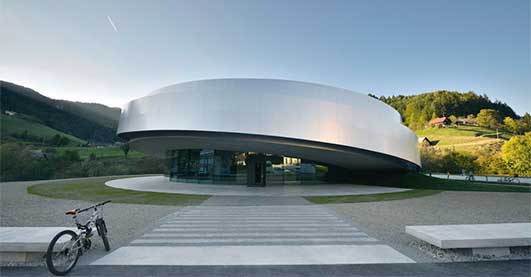
photo : Tomaz Gregoric
Cultural Center of European Space Technologies in Slovenia
650 apartments, Ljubljana
Design: Ofis Arhitekti
Website: Mountain Skuta
Comments / photos for the Alpine Shelter on Mountain Skuta page welcome
Website: OFIS ARCHITECTS

